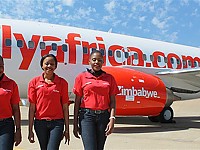This post may contain affiliate links. We may earn money or products from the highlighted keywords or companies or banners mentioned in this post.

Industry experts said that the growth of low fare airlines in Zimbabwe is expected to help spur the growth of the tourism sector as connectivity improves and the cost of traveling becomes more affordable.
The government has decided to adopt an open skies policy that has led to the entry of 2 low-cost airlines into the Zimbabwe market, and it has relaxed the visa requirements for emerging-economies in a bid to increase arrivals to more than 3.2 million this year. The government has also run a campaign that is aimed at improving peoples’ perception of Zimbabwe as a security risk.
Budget airline, Fly Africa, which was licensed in August last year by the Civil Aviation Authority of Zimbabwe (CAAZ), began flying in November from Victoria Falls to Johannesburg and Harare to Johannesburg. The airline has since expanded its routes to include the Bulawayo to Johannesburg and Harare to Johannesburg routes.
Another low cost airline, Fastjet, last month obtained an air-service permit (ASP) from the government, the next-to-last step before getting an air operator certificate that will enable the carrier to operate in Zimbabwe. Last year, the airline introduced flights on the Harare – Dar es Salaam route. The two low-cost airlines have left the national carrier, Air Zimbabwe that is plagued by operational difficulties, in the shade.
Air Zimbabwe has reacted by reviving their flights to the tourism hot-spot of Kariba and has announced plans to revive the Harare – Masvingo – Chiredzi route.
Industry players said that all this is great news for the tourism sector, since it will improve the accessibility to tourism destinations and as a result boost the confidence of marketers and travelers.
Low-cost airline, Fastjet said that it has been able to identify many potential routes from and within Zimbabwe where the airline believes that the low-cost model will spur the market and tap into the large market of passengers traveling by bus.
Industry players said that the entry of Fastjet will improve destination connectivity between various tourism spots in Zimbabwe. They also said that the growth of low-cost aviation will not only improve traveling effectiveness but also tourist movement, both regionally and domestically.
Clement Mukwasi, president of Employers Association of Tourism and Safari Operators said that they have been having an accessibility problem, but the introduction of the new airplanes into the market will lead to an increase in the total arrivals in Victoria Falls and this is going to resuscitate the business.
Clement said that they’re seeing Victoria Falls becoming the main hub for aviation, and it would take over from Johannesburg which is presently providing the shortest-connection in Southern Africa. Consequently, the licensing of more airlines can win over more customers who’re presently using the Johannesburg route.
Clement added that the airlines are increasing their capacity so that they can be able to accommodate the anticipated increase in arrivals after the renovations being done at the Victoria Falls International Airport are completed.
The $150 million Chinese-funded expansion will greatly improve its aircraft handling capacity and it includes expansion of the existing-runway, construction of a new 4 kilometer runway, construction of a new terminal building, and car park and road network.
The new terminal is going to be used for international flights and the existing terminal will be converted to domestic use since the new facility will be able to handle over twice its current handling capacity of 500,000 passengers/yr.










